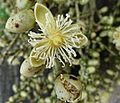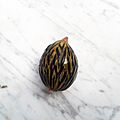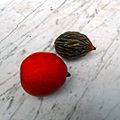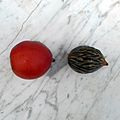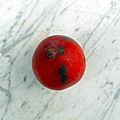Foxtail palm facts for kids
Quick facts for kids Foxtail palm |
|
|---|---|
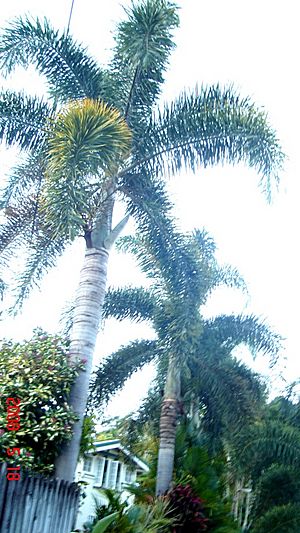 |
|
| Conservation status | |
| Scientific classification | |
| Genus: |
Wodyetia
|
| Species: |
bifurcata
|
The foxtail palm (scientific name: Wodyetia bifurcata) is a special type of palm that grows naturally in Queensland, Australia. It's the only species in its group, called Wodyetia.
This palm is very pretty! It has long, feathery leaves that look a bit like a fox's tail, which is how it got its common name. It can grow up to 10 meters (about 33 feet) tall and has a smooth, gray trunk. When its fruits are ripe, they are bright orange and about the size of a duck egg.
Contents
Where the Foxtail Palm Got Its Name
Most people around the world didn't know about this amazing palm until 1978. That's when an Aboriginal man shared it with scientists.
The Aboriginal man's name was "Wodyeti." Because of him, scientists decided to name the palm's group (its genus) Wodyetia. The second part of its scientific name, "bifurcata," comes from a Latin word meaning "divided into two parts." This refers to the way the fibers covering the seeds split into two.
What the Foxtail Palm Looks Like
Foxtail palms are easy to spot because of their unique features.
Flowers
The foxtail palm has white flowers that grow on a stalk. This stalk comes out from the bottom of the crownshaft, which is the smooth, green part just below the leaves.
Leaves
The leaves of the foxtail palm can be different shades of green, from deep to light. They are very full and bushy, looking like a fox's tail. This is why it's called the foxtail palm!
Fruits
The fruits of the foxtail palm are about 5 centimeters (2 inches) long. When they are young, they are olive green. But when they are ready to be picked, they turn a bright orange-red color.
Trunk
The trunk of the foxtail palm is smooth and cleans itself, meaning old leaf bases fall off easily. It can grow as a single trunk, or sometimes with two or three trunks together. The trunk is usually a bit wider in the middle and can reach heights of about 9 meters (30 feet). Its color changes from dark gray to light gray, and eventually, it can look almost white. The crownshaft, which is the part where the leaves meet the trunk, is bright green and slightly swollen at its base.
Where Foxtail Palms Grow
This palm naturally grows only in a very small area of Australia. You can find it in the Cape Melville range, which is part of the Cape Melville National Park in Queensland.
When the foxtail palm was first discovered in 1978, it was considered a rare plant. It was even listed as a threatened species by the IUCN.
After the world learned about this beautiful palm, its seeds became very popular. People wanted them so much that an illegal trade started, and many wild foxtail palms were almost wiped out. Luckily, the palm grows easily when planted by people. This helped reduce the pressure on the wild plants. Now, the foxtail palm is grown all over the world and is one of the most popular palms.
Foxtail Palm's Home
The foxtail palm lives in a very specific part of Australia. It grows on rocky, gravelly hills in the Cape Melville range, all within the Cape Melville National Park.
This area is known for its rich mix of nature and Aboriginal culture. It has a long history with Aboriginal people and is home to many different kinds of plants and animals.
See also
 In Spanish: Wodyetia para niños
In Spanish: Wodyetia para niños





